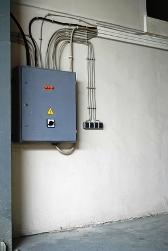Transient processes in the electrical circuit
 Transient processes are not unusual and are characteristic not only of electrical circuits. A number of examples can be cited from various fields of physics and technology where such phenomena occur.
Transient processes are not unusual and are characteristic not only of electrical circuits. A number of examples can be cited from various fields of physics and technology where such phenomena occur.
For example, hot water poured into a container is gradually cooled and its temperature changes from an initial value to an equilibrium value equal to the ambient temperature. A pendulum brought from a state of rest performs damping oscillations and eventually returns to its original stationary stationary state. When an electrical measuring device is connected, its needle, before stopping at the corresponding scale division, makes several oscillations around this point on the scale.
Stationary and transient mode of the electric circuit
When analyzing the processes in electrical circuits you should encounter two modes of operation: established (stationary) and transient.
The stationary mode of an electrical circuit connected to a source of constant voltage (current) is a mode in which the currents and voltages in the individual branches of the circuit are constant over time.
In an electric circuit connected to an alternating current source, the stationary state is characterized by periodic repetition of the instantaneous values of currents and voltages in the branches... In all cases of operation of circuits in stationary modes, which theoretically can continue indefinitely, it is assumed that the parameters of the active signal (voltage or current), as well as the structure of the circuit and the parameters of its elements, do not change.
Currents and voltages in stationary mode depend on the type of external influence and on the parameters of the electrical target.
A transient mode (or a transient process) is called a mode that occurs in an electrical circuit during the transition from one stationary state to another, which is somehow different from the previous one, and the voltages and currents accompanying this mode — transient voltages and currents... A change in the steady state of a circuit can occur as a result of changing external signals, including turning on or off a source of external influence, or it can be caused by switching in the circuit itself.

Switching of an electric circuit — the process of switching the electrical connections of the elements of the electric circuit, disconnecting a semiconductor device (GOST 18311-80).
In most cases, it is theoretically permissible to assume that the switching takes place instantaneously, i.e. various switches in the circuit are performed without taking much time. The switching process in diagrams is usually shown by an arrow near the switch.
Transient processes in real circuits are fast... Their duration is tenths, hundredths and often millionths of a second. Relatively rarely, the duration of these processes reaches a few seconds.
Naturally, the question arises whether it is generally necessary to take into account transient regimes of such short duration. The answer can only be given for each specific case, since under different conditions their role is not the same. Their importance is especially great in devices designed for amplification, formation and conversion of pulse signals, when the duration of the signals acting on the electrical circuit is commensurate with the duration of the transient modes.
Transients cause the shape of pulses to be distorted as they pass through linear circuits. Calculation and analysis of automation devices, where there is a continuous change in the state of electrical circuits, is unthinkable without taking into account transient modes.
In a number of devices, the occurrence of transient processes is generally undesirable and dangerous. The calculation of transient modes in these cases makes it possible to determine possible overvoltages and current increases, which can be many times higher than the voltages and currents of the stationary mode. This is especially important for circuits with significant inductance or high capacitance.
The reasons for the transition process
Let's consider the phenomena that occur in electric circuits during the transition from one stationary mode to another.
We include the incandescent lamp in a series circuit containing a resistor R1, a switch B and a constant voltage source E.After the switch is closed, the lamp will immediately light up, since the heating of the filament and the increase in the brightness of its glow are invisible to the eye. Conditionally, it can be assumed that in such a circuit the stationary current is equal to Azo =E / (R1 + Rl), it is installed almost immediately, where Rl — active resistance of the filament of the lamp.
In linear circuits consisting of energy sources and resistors, transients associated with a change in stored energy do not occur at all.
Rice. 1. Schemes to illustrate transient processes: a — circuit without reactive elements, b — circuit with an inductor, c — circuit with a capacitor.
Replace the resistor with an L coil whose inductance is large enough. After closing the switch, you can notice that the increase in brightness of the lamp glow is gradual. This shows that due to the presence of a coil, the current in the circuit gradually reaches its steady state value. I'about =E / (rDa se + Rl), where rk — active resistance of the coil winding.
The next experiment will be carried out with a circuit consisting of a source of constant voltage, resistors and a capacitor, in parallel with which we connect a voltmeter (Fig. 1, c). If the capacity of the capacitor is large enough (several tens of microfarads) and the resistance of each of the resistors R1 and R2 several hundred kilo-ohms, then after closing the switch, the needle of the voltmeter begins to smoothly deviate and only after a few seconds it is set to the appropriate division of the scale.
Therefore, the voltage in the capacitor, as well as the current in the circuit, is established for a relatively long period of time (the inertia of the measuring device itself in this case can be neglected).
What prevents the instantaneous establishment of a stationary mode in the circuits of fig. 1, b, c and the reason for the transition process?
The reason for this is the elements of electric circuits capable of storing energy (the so-called reactive elements): inductor (Fig. 1, b) and capacitor (Fig. 1, c).

The energy accumulated in the electric field of a capacitor of capacity C charged to a voltage ti° C is equal to: W° C = 1/2 (Cu° C2)
Since the supply of magnetic energy WL is determined by the current in the coil iL and electric energy W° C — voltage in the capacitor ti° C, then in all electric circuits, any three commutations, two basic provisions are observed: the coil current and the capacitor voltage they cannot change sharply... Sometimes these regulations are formulated differently, namely: the relationship of the coil flux and the capacitor charge can only change smoothly, without jumps.
Physically, transition modes are processes of transition of the energy state of the circuit from the pre-commutation mode to the post-commutation mode. Each stationary state of a circuit with reactive elements corresponds to a certain amount of energy of electric and magnetic fields.The transition to a new stationary mode is associated with an increase or decrease in the energy of these fields and is accompanied by the appearance of a transient process that ends as soon as the change in energy supply stops. If during switching the energy state of the circuit does not change, then no transients occur.

a) switching on and off the circuit,
b) short circuit individual branches or elements of the chain,
c) disconnection or connection of branches or circuit elements, etc.
In addition, transients occur when pulse signals are applied to electrical circuits.

